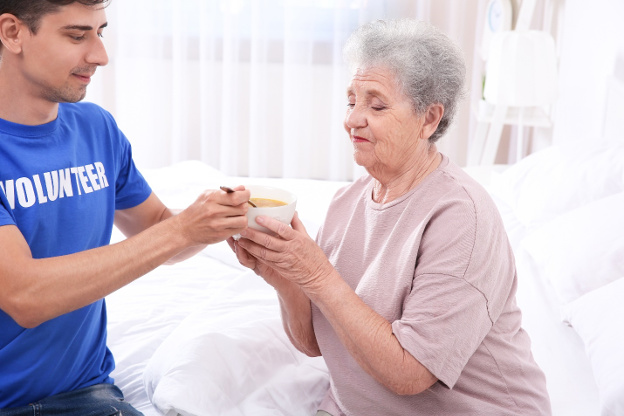THE TRANSITION TO HOSPICE AND ITS IMPACT ON FAMILY MEMBERS: STRATEGIES FOR PROFESSIONAL CAREGIVERS
End-of-life care can be fraught with emotion, confusing, and overwhelming for family members. Hospice nurses and other caregivers not only care for patients, they also educate and provide emotional and psychological support to family members.

Research has shown that hospice has downstream benefits to family members, especially spouses.1 Additionally, families of cancer patients enrolled in hospice reported better outcomes and were more satisfied with the end-of-life care their loved one received.2
Considering the exceptionally sensitive nature of end-of-life care, training for professional caregivers is crucial. Comprehensive palliative and hospice care training programs can help ensure healthcare staff have the information and tools they need to adequately care for hospice patients and their family members.
Ahead we’ll look at some strategies for professional caregivers working in end-of-life care. First, let’s take a closer look at hospice and how it’s used in the U.S.
THE MISSION OF HOSPICE CARE
The modern hospice movement in the U.S. was established in the mid to late 1960s and has become the model for compassionate care for people with life-limiting illness.3
Hospice is not a place, it’s a philosophy. Its foundational mission is to provide quality medical care, pain management, and emotional and spiritual support. The focus is on caring, not curing.
Most care is provided in places a patient calls home, whether it’s a private residence or a nursing home. A very small percentage of care (less than 2%) is delivered in inpatient hospice facilities.4
Hospice takes a holistic view and treats the patient and their family members as a care unit. In addition to tending to a patient’s medical and comfort needs, hospice also educates family members about the emotional, psychosocial, and spiritual aspects of dying, and provides both immediate and ongoing grief support and counseling to surviving family members and friends. For many family members, a loved one’s death is just the beginning of their hospice journey.

Hospice teams are interdisciplinary, with patients and family members/caregivers at the center, surrounded by nurses, physicians, home health aides, spiritual counselors, bereavement counselors, therapists, social workers, and volunteers.
Family members usually serve as primary caregivers and may help make decisions for the terminally ill person. Hospice caregivers typically play a supportive role, making regular visits to the patient to provide additional care and other services.
HOSPICE STATISTICS IN THE U.S.
Hospice use has increased in the U.S. However, misconceptions about hospice persist, which may lead fewer people to enroll in hospice care. Although most would prefer to die at home, a large percentage of people in the U.S. die in the hospital.5,6
Still, the demand for hospice has grown in recent years and will continue to grow as America’s population ages. The number of Americans age 85 and older is projected to double by 2050, when people in this age group will make up 4.5% of the population.7
According to data compiled by the National Hospice and Palliative Care Organization:4
- In 2016, more than 1.4 million Medicare beneficiaries were enrolled in hospice care. Of these enrollees:
- More than half (58%) were female.
- Approximately 64% were 80 years of age or older.
- A significant majority (86.5%) were Caucasian.
- More than 27% had cancer as their principal diagnosis, followed by cardiac and circulatory conditions (18.7%); dementia (18%); respiratory illnesses (11%); stroke (9.5%); other (15.6%).
- In 2016, the vast majority (98%) of days of care for Medicare hospice patients were provided at the routine home care (RHC) level. Routine home care refers to care delivered in the patient’s home (private residence, nursing home, or assisted living facility).
- Most days of routine home care were provided at private homes (55.6%) or nursing facilities (42%); only 1.3% of RHC was provided in hospice inpatient facilities (1.3%), followed by acute care hospitals (0.5%), and other locations (0.8%).
- In 2016, 1.04 million Medicare beneficiaries died while enrolled in hospice care. Most died at home (44.6%) or in nursing homes (32.8%); 14.6% died in inpatient hospice facilities, 7.4% in acute care hospitals, and 0.7% in other locations.

STRATEGIES FOR PROFESSIONAL CAREGIVERS IN EDUCATING AND PREPARING FAMILY MEMBERS
The hospice direct care team may include registered nurses (RNs), licensed vocational and practical nurses (LVNs/LPNs), certified nursing assistants (CNAs), and home health aides.
The team works together to manage patients’ pain and other symptoms, create a plan of care with primary (family) caregivers, provide respite care for family members, and arrange spiritual support services. The team provides emotional support, advocates for patients, and makes sure patients’ wishes are honored.
Nurses play a critical role in educating family members about what to expect when their loved one is transferred to hospice care. Strategies they use to guide family members through the process can include:
- Listening : One family member may feel compelled to take extensive notes in order to understand and process what’s happening with their loved one, while another may be more visual and prefer to learn by seeing. By listening carefully, hospice nurses can learn which communication method each family member prefers and adapt to their needs.
- Establishing trust : Listening intently, responding with empathy and compassion, respecting a family’s views and values on death and dying, and taking time to thoroughly explain what’s happening and answer questions are key to building trust with family members.
- Preparing family members : It’s important to begin preparing family members early on but also to avoid bombarding them with information they may not be able to digest at once. Family members need to know what to expect as their loved one’s condition progresses and who and when to call for help. Nurses can help family members prepare for their loved one’s decline by educating them on what to expect, such as changes in appetite and respiratory patterns.
- Repeating information : It’s normal and common for family members to feel overwhelmed. They may not be able to absorb all the information they receive. In the early stages of the transition to hospice, especially, some family members may not be ready to discuss death or dying. Patience is a virtue among professional caregivers, who may need to repeat information often to help family members fully grasp what’s happening.
- Being present : Sometimes doing nothing can make a world of difference-sitting silently at a patient’s side and holding their hand, sharing stories with patients and family members, and just being present. Willingness to face pain and grief head on and deal with uncomfortable situations and uncertainty are what set palliative and hospice caregivers apart.

HOW FAMILY COMMUNICATION PATTERNS AFFECT DECISIONS
The challenging nature of hospice work is often compounded by family dynamics and communication patterns. This is especially true in situations where families refuse or are hesitant to talk about death and dying or try to conceal the transition to hospice from the patient.
- Research has found that families who communicate openly and don’t have distinct hierarchical family structures (e.g., pluralistic families) are often able to come to a consensus about care for their loved one and have better experiences in hospice.8
- Conversely, families that have low communication and a strict hierarchy (protective families) in which one family member dominates may have difficulty reaching an agreement about the best course of action for their loved one.
When hospice nurses are trained to assess family communication patterns, they’re better equipped to assess when interventions may be appropriate and identify family caregivers who are struggling and may need additional support.
CAREGIVERS NEED SUPPORT, TOO
End-of-life care is one of the most challenging areas of healthcare, but also one of the most rewarding. Nurses, LVNs, CNAs, and others who provide direct care to patients in hospice need support, too. Quality training programs can help direct care workers navigate the challenges of end-of-life care. Medcom’s hospice care training can help.

Medcom’s Featured Series – Hospice Series
Medcom has developed a suite of five courses designed specifically for professional and paraprofessional caregivers dealing with end-of-life care. Courses in our Hospice Series include:
- Hospice Care: Home Versus the Long-Term Care Facility
- Palliative Pain Management in Home Health Care
- Providing Hospice Service in the Home
- The Role of the Hospice Nurse on the Healthcare Team
- Transitioning the Resident to Hospice Care
The affordable series is an excellent addition to your existing training program and is designed to provide caregivers with hours of healthcare education in a simple, easy-to-follow format. Caregivers can access these courses anytime, anywhere, on any device with an internet connection, and they’ll earn certificates of completion upon passing the post-review tests.
For more information and a free preview of Medcom’s Caregiver Training Series, please contact Mike McAllister at 800-541-0253, ext. 213, or email [email protected]
Click here to view our complete catalog of home care, hospice, and home health care training courses.
ABOUT MEDCOM
For more than 50 years, Medcom has been a trusted education provider among healthcare professionals, students, patients, and their loved ones. Our vast library of products is used nationwide by universities, hospitals, long-term care facilities, home health, hospice, and home care providers.
Medcom offers a complete suite of online education videos for nurses and other healthcare professionals, as well as nurse CE programs, to help ensure quality care. Our award-winning products not only meet regulatory compliance, but the Medcom solution is cost-effective, meets in-service and continuing education needs, and boosts employee retention. To ensure the highest level of quality, we have worked with leading healthcare and professional organizations, such as the American Lung Association, Johns Hopkins Hospital, and the Mayo Clinic. To learn more, visit www.medcomrn.com
Sources :
- http://www.todaysgeriatricmedicine.com/news/ex_080515.shtml
- https://ascopubs.org/doi/full/10.1200/JCO.2016.68.9257
- https://www.nhpco.org/history-hospice-care
- https://www.nhpco.org/sites/default/files/public/Statistics_Research/2017_Facts_Figures.pdf
- https://www.cdc.gov/mmwr/volumes/65/wr/mm6513a6.htm
- https://palliative.stanford.edu/home-hospice-home-care-of-the-dying-patient/where-do-americans-die/
- https://www.forbes.com/sites/robinseatonjefferson/2017/09/27/old-age-aint-no-place-for-sissies-more-than-ever-americas-50m-seniors-need-to-know-their-rights/#133dc3a918fa
- https://www.ncbi.nlm.nih.gov/pmc/articles/PMC3269241/
